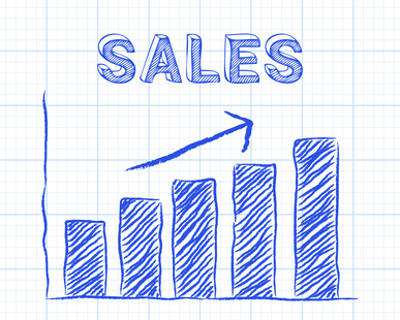Every salesperson has received negative responses at some point in their career, whether a definitive "No!" or simply no decision having been made yet. And many of them!
Studies have shown that it can take up to five follow-ups for 80% of sales to occur, yet over 40% of salespeople give up after only one "no"?
Because as disappointing as it sounds, given the chance to follow up and close the sale, many salespeople simply do nothing. When surveyed, their responses range from "I don't want to bother the prospect" to "I don't know what to say" and "I don't know when to make the calls".
And their failure to follow up affects more than just their quota. Not only does it leave the prospect without a solution to their problem, but it also affects the company, as the cost of lead acquisition is essentially lost.
Mastering the art and science of
effective sales follow-up can be quite challenging, but it is a critical part of the sales process. After all, the deal isn't complete until the customer has signed on the dotted line.
Following up on your prospects is a crucial part of the sales process, but how you do it depends on a wide range of factors. It can depend on what stage they are in the sales cycle, what medium you approach them on, and a combination of these.
To help you improve the way you work, here are 5 tips for an effective follow up in sales.
1) Ask them for the best way to follow up
It's important that salespeople understand that by closing a sale, they are creating a win-win situation. The client needs your services to solve a problem they have and you'll get paid for providing this service. Understanding this should help quell the guilt that some people feel when they have to make follow up calls.
With the first call done, ask the prospect for their preferred form of communication. You can also set an expectation for responsiveness by asking about timelines for replying to follow-up messages.
Pre-arranging the follow-up via an agreed medium helps you avoid the game of cat-and-mouse that would inevitably occur without an agreed follow up.

2) Always have a reason to reconnect
Now I'm going to save you loads of time, both on calls, and on future learning as a salesperson.
One of the most important points to remember is to never just "check in" with a prospect.
The phrases "just checking in" and "touching base" signify that there is no reason for your call or email – which, in the mind of a busy executive – automatically translates into "there is no reason for me to speak with you".
Effectively, the book Action Selling by Duane Sparks is really an entire book on avoiding this issue, and what to do in its place. If you do like reading to improve yourself, this is a good one to build on this point.
Rather, make every follow up count by committing to deliver value and build trust with all your calls and emails. Rather than simply calling to follow up, take the time to weave in a compelling reason for your call. Sparks builds on this, but in the previous
blog post I made, I referred to the Mackay 66. Essentially, the Mackay 66 is looking at giving you 66 reasons to call somebody! If you haven't learnt this yet, get hold of one of his books that includes the Mackay 66.
And lastly, on this point, always use your follow up calls to subconsciously remind prospects about why they invested time in talking with you in the first place.
3) Never follow up ‘blind'
Do you know if your emails are going unread or if they end up straight in the spam folder? A study by Yesware found that you have a 20% chance of getting a reply to your second email even if the first goes unanswered.
However, statistics show that 70% of unanswered sales emails stop after only the first attempt, and only 19% send a second email. Why are so many salespeople quitting so soon? Emails can be effective for outreach, but because your prospect receives so many every day, it can be difficult to get through the noise.
To track your email outreach efforts, you can use a service like Yesware. The Yesware plugin allows you to track your email opens and see which links were clicked on. You can then use this data to understand how your recipients are interacting with your emails, which can help you define your lead nurturing efforts.
Two other tools that are brilliant for the follow-up process are Followup.cc and Boomerang. When added to your email's CC field, the former will remind you to follow up, while Boomerang sends you inbox reminders to follow up on your prospects.
4) Know when to stop
Attempting to make them see just how valuable you are (and basically push them into making a decision) will only end in disaster. No client owes you anything.
A lack of follow up isn't a signal for you to switch to pushy salesperson mode. Their final decisions will be based on what's best for their business, not yours, and you need to respect that. Yes, it can take time to close some sales, but misaligning your pitch with your prospect's buyer stage can only come across as aggressive – two qualities that will make your prospect take their business elsewhere.
An experienced salesperson also knows that by knowing when to stop, and actually leaving a pleasant taste in the prospect's mouth, often leads to other business later on. maybe you don't win this particular deal, but they'll remember you when they need something else, and come back to you, and that particular deal will surprise you by how easy it seemed!

5) Create a follow-up plan
Most salespeople are reluctant to follow up for the same reason: they don't have an actual plan for following up, which leads to reluctance as they don't want to come across as unprepared.
To avoid this, create a follow up process that your sales team is comfortable using: a plan that walks them through effectively contacting the prospect. Make sure this plan includes:
- Tips on crafting different follow up messages so they don't send the same message twice.
- How to personalise the follow up based on the prospect's previous action or inaction.
- Creating a well-thought out sequence that provides value or a compelling reason for them to respond.
- A reminder on always remaining polite.
Following up can be a little scary as it's tinged with so much uncertainty, but remember that the prospect has expressed some interest in your service already. Therefore, you should take the steps needed to help you move closer to a sale.

Effective follow up goes beyond simply calling and blindly sending the same emails over and over again – the most successful salespeople make their follow ups valuable to their prospects.

If you'd like to learn more about selling skills, why not take a look at how we can help?
Boost your sales skills with our online courses.
RRP from $39 – limited time offer just
$12.99
How do you feel about following up on a prospect? Have you found it useful in helping you close more sales? Let us know in the comments below.




























